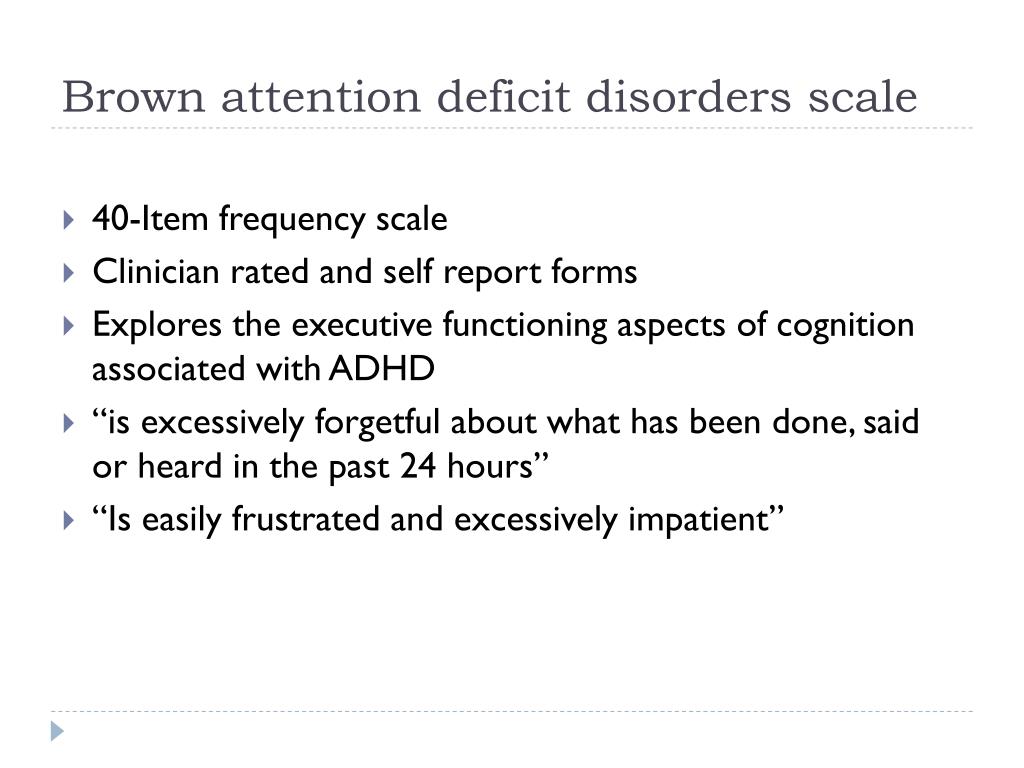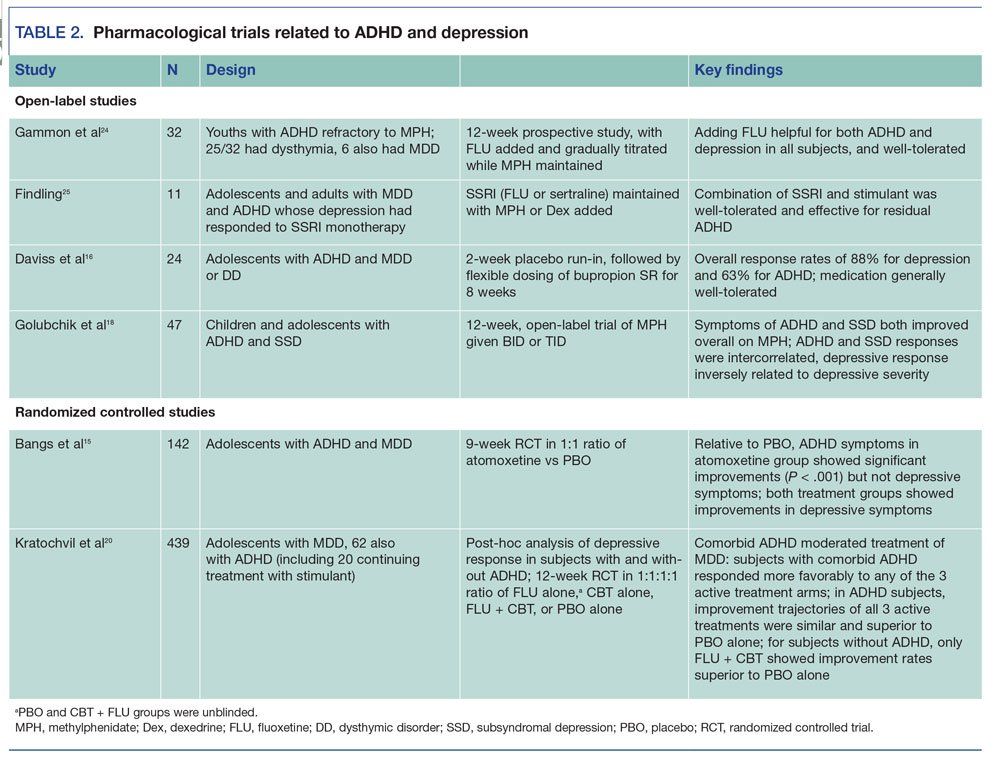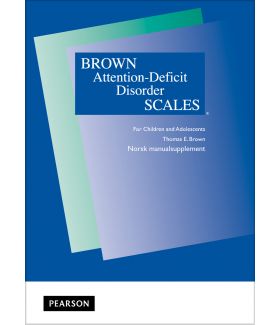

- #Brown attention deficit disorder scales for adolescents full
- #Brown attention deficit disorder scales for adolescents software
The software accepts record form inputs maintains multiple record forms for an examinee exports record form data and generates a graphical and narrative report. Simplify scoring and reporting with the efficient Brown ADD Scales Scoring Assistant® which allows you to quickly score and analyze results from all the Brown ADD Scales.
#Brown attention deficit disorder scales for adolescents full
Results indicate whether the individual appears to have ADD and would benefit from a full evaluation for the disorder.

T scores indicate how much impairment the examinee is showing on each of the clusters, relative to a normative population. The convenient READY SCORE® form gives immediate cluster scores and a total score indicating overall impairment from a broad range of ADD symptoms. Monitoring and Self-Regulating Action (Children’s edition only).

Utilizing Working Memory and Accessing Recall.Based on Thomas Browns cutting-edge model of cognitive impairment in ADD, BrownADDScales reliably screen for and explore the executive cognitive functioning associated with ADHD. Managing Frustration and Modulating Emotions Brown Attention-Deficit Disorder Scales® are a consistent measure of ADD across the life span. Presenting with persistent inattentiveness and/or hyperactivity and impulsivity severe enough to interfere with functioning, and occurring in more than one setting, attention deficit hyperactivity.Regulating Alertness, Sustaining Effort and Processing Speed.Based on Thomas Brown's cutting-edge model of cognitive impairment in ADD, BrownADDScales reliably screen for and explore the executive cognitive functioning associated with ADHD.
 Focusing, Sustaining and Shifting Attention to Tasks Brown Attention-Deficit Disorder Scales are a consistent measure of ADD across the life span. Organizing, Prioritizing and Activating to Work. Clusters of executive functions assessed include: Brown Attention-Deficit Disorder Rating Scale and Diagnostic Form Asks about clinical history, early schooling, family history, physical health, substance use, sleep habits physician also obtains. The Brown ADD Scales go beyond measures that address only hyperactivity to assess for less apparent impairments of executive functioning. Interpret and link performance with IQ and other assessment data, including integrations with WAIS-III and WISC-III. Administer any of 40 to 50-item efficient screening instruments in just 10 to 20 minutes. Use in multiple settings: for screening, as part of a comprehensive diagnosis, and for monitoring of treatment responses in a wide range of educational, clinical, and managed care settings. Gather and integrate important diagnostic information about an individual, with cluster and total scores arriving at a diagnostic decision. Brown, PhD June 11, 2 PM ET Are you feeling frustrated that you don’t have immediate results from your. We recommend those planning to conduct evidence-based assessments with children referred for difficulties consistent with ADHD consult these sources.With the new Brown ADD Scales for Children that include a primary/preschool scale (ages 3–7) and a school-age scale (ages 8–12), in addition to the adolescent and adult scales already available, the Brown ADD Scales allow you to comprehensively assess ADD in individuals of all ages. CHADD Webinar: 4 Common Problems in ADHD Treatment for Teens and Adults Featuring Thomas E. Where appropriate, throughout the chapter we refer the reader to more detailed sources. It is not possible to do justice to this extensive literature in a single chapter. 364).Īttention-deficit/hyperactivity disorder has been the subject of a great deal of research attention over the last three decades with many research articles and books published describing its nature, assessment, and treatment. In preparing this chapter we have been guided by Mash and Hunsley's description of evidence based assessment, “… assessment methods and processes that are based on empirical evidence in terms of both their reliability and validity as well as their clinical usefulness for prescribed populations and purposes” (Mash & Hunsley, 2005, p. We also consider the difficulties in combining data across informants and measures and the important issue of incremental validity: that is, when does more assessment lead to better assessment and outcome? Although the focus of the chapter is the assessment of ADHD in school-aged children we briefly address the assessment of ADHD in preschoolers, adolescents, and adults. In this chapter we briefly review what is known about attention-deficit/hyperac-tivity disorder (ADHD) before considering the informants, methods, and measures that can be used to conduct evidence-based assessments for children presenting with problems suggestive of ADHD. Following recognition of the need for evidence-based treatments for childhood disorders there is increasing awareness that the assessment procedures we use with children should also be evidence-based.
Focusing, Sustaining and Shifting Attention to Tasks Brown Attention-Deficit Disorder Scales are a consistent measure of ADD across the life span. Organizing, Prioritizing and Activating to Work. Clusters of executive functions assessed include: Brown Attention-Deficit Disorder Rating Scale and Diagnostic Form Asks about clinical history, early schooling, family history, physical health, substance use, sleep habits physician also obtains. The Brown ADD Scales go beyond measures that address only hyperactivity to assess for less apparent impairments of executive functioning. Interpret and link performance with IQ and other assessment data, including integrations with WAIS-III and WISC-III. Administer any of 40 to 50-item efficient screening instruments in just 10 to 20 minutes. Use in multiple settings: for screening, as part of a comprehensive diagnosis, and for monitoring of treatment responses in a wide range of educational, clinical, and managed care settings. Gather and integrate important diagnostic information about an individual, with cluster and total scores arriving at a diagnostic decision. Brown, PhD June 11, 2 PM ET Are you feeling frustrated that you don’t have immediate results from your. We recommend those planning to conduct evidence-based assessments with children referred for difficulties consistent with ADHD consult these sources.With the new Brown ADD Scales for Children that include a primary/preschool scale (ages 3–7) and a school-age scale (ages 8–12), in addition to the adolescent and adult scales already available, the Brown ADD Scales allow you to comprehensively assess ADD in individuals of all ages. CHADD Webinar: 4 Common Problems in ADHD Treatment for Teens and Adults Featuring Thomas E. Where appropriate, throughout the chapter we refer the reader to more detailed sources. It is not possible to do justice to this extensive literature in a single chapter. 364).Īttention-deficit/hyperactivity disorder has been the subject of a great deal of research attention over the last three decades with many research articles and books published describing its nature, assessment, and treatment. In preparing this chapter we have been guided by Mash and Hunsley's description of evidence based assessment, “… assessment methods and processes that are based on empirical evidence in terms of both their reliability and validity as well as their clinical usefulness for prescribed populations and purposes” (Mash & Hunsley, 2005, p. We also consider the difficulties in combining data across informants and measures and the important issue of incremental validity: that is, when does more assessment lead to better assessment and outcome? Although the focus of the chapter is the assessment of ADHD in school-aged children we briefly address the assessment of ADHD in preschoolers, adolescents, and adults. In this chapter we briefly review what is known about attention-deficit/hyperac-tivity disorder (ADHD) before considering the informants, methods, and measures that can be used to conduct evidence-based assessments for children presenting with problems suggestive of ADHD. Following recognition of the need for evidence-based treatments for childhood disorders there is increasing awareness that the assessment procedures we use with children should also be evidence-based.








 0 kommentar(er)
0 kommentar(er)
